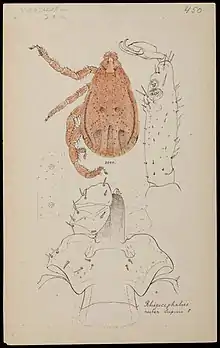Rhipicephalus haemaphysaloides
Rhipicephalus haemaphysaloides is a hard-bodied tick of the genus Rhipicephalus. It is one of the major medically important ticks in the world.
| Rhipicephalus haemaphysaloides | |
|---|---|
 | |
| Scientific classification | |
| Kingdom: | Animalia |
| Phylum: | Arthropoda |
| Subphylum: | Chelicerata |
| Class: | Arachnida |
| Subclass: | Acari |
| Order: | Ixodida |
| Family: | Ixodidae |
| Genus: | Rhipicephalus |
| Species: | R. haemaphysaloides |
| Binomial name | |
| Rhipicephalus haemaphysaloides Supino, 1897 | |
| Synonyms | |
| |
Distribution
It is found in Indonesia, Myanmar, India, Sri Lanka, Thailand, Pakistan, and Vietnam.[1]
Parasitism
It is an obligate ectoparasite of domestic mammals such as cattle, horses, sheep, and dogs. It is a potential vector of babesiosis and human Kyasanur Forest disease.[2][3] It is a three-host tick.[4]
References
- "Species Details : Rhipicephalus haemaphysaloides Supino, 1897". Catalogue of Life. Retrieved 11 February 2017.
- Wang, Yujian; Zhou, Yongzhi; Gong, Haiyan; Cao, Jie; Zhang, Houshuang; Li, Xiangrui; Zhou, Jinlin (2015). "Functional characterization of a cystatin from the tick Rhipicephalus haemaphysaloides". Parasites & Vectors. 8: 140. doi:10.1186/s13071-015-0725-5. PMC 4352250. PMID 25889816.
- Bhat, HR; Naik, SV; Ilkal, MA; Banerjee, K (1978). "Transmission of Kyasanur Forest disease virus by Rhipicephalus haemaphysaloides ticks". Acta Virol. 22 (3): 241–4. PMID 27975.
- "Experimental transmission of Babesia microti by Rhipicephalus haemaphysaloides". Li et al. Parasites & Vectors. Retrieved 11 February 2017.
External links
| Wikimedia Commons has media related to Rhipicephalus haemaphysaloides. |
- Lipopolysaccharide-Induced Differential Expression of miRNAs in Male and Female Rhipicephalus haemaphysaloides Ticks
- LIFE CYCLE OF RHIPICEPHALUS HAEMAPHYSALOIDES SUPINO, 1897 (ACARI: IXODIDAE) UNDER LABORATORY CONDITIONS
- Isolation and characterization of two novel serpins from the tick Rhipicephalus haemaphysaloides
- Biological character of Rhipicephalus haemaphysaloides haemaphysaloides in Fujian, China 1992
This article is issued from Wikipedia. The text is licensed under Creative Commons - Attribution - Sharealike. Additional terms may apply for the media files.
